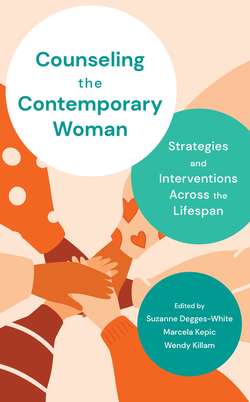Читать книгу Counseling the Contemporary Woman - Suzanne Degges-White - Страница 86
Transition to Committed Life and Family Life
ОглавлениеFamily relations can play a significant role in a woman’s life from birth to death. According to the family life cycle model (Carter & McGoldrick, 2015), young adults typically leave their nuclear family, enter into a committed relationship, then build a family-of-creation. Learning to share your life and home with a significant other is not always easy. While dating, there are seldom arguments about whose turn it is to take the trash out, do the dishes or laundry, shop for groceries, or feed the cats; these can pop up quickly in some marriages. Another common challenge for couples is the maintenance of friendships outside of marriage. Single friends may not want to hang out with a couple, or perhaps one partner does not like the other’s friends. Partners may be jealous of the time their spouse spends with friends or may simply dislike a partner’s friend. Negotiating where time is spent during significant holidays can also cause conflict. For the couple, it can be challenging to learn how to function as a new family unit. Some couples may need to seek outside assistance, such as working with a counselor.
Another phase of the family life cycle—starting a family or childbearing—brings many new challenges. Just as the young couple becomes comfortable with committed or married life, a newborn baby throws that routine completely off. Suddenly, the centeredness around two partners shifts to centeredness around the newborn. Despite the fact that both partners are happily expecting the child and some changes associated with adding a new family member, the arrival of the baby changes the dynamics between the couple, where a new mom could completely be consumed by the needs of a newborn and deprived of sleep and a new dad or partner experiences feelings of being left out of the dyad. Such shifts contribute to feelings of being overwhelmed, exhausted, and not understood. Mothers after giving birth may experience either baby blues or postpartum depression, possibly stemming from fluctuating hormones and other environmental factors. According to the Centers for Disease Control and Prevention (CDC) (2019), approximately 70 to 80 percent of mothers will experience the “baby blues” after giving birth. Postpartum depression, something much more severe, is experienced by 10 to 15 percent of new mothers (CDC, 2019). The appearance of these can complicate adjustment to and the necessary shift in a couple’s dynamics. If symptoms of either of these are present in your client, assess for depression and engage the client in appropriate treatment as quickly as possible.
Research suggests that marriage provides multiple benefits for couples. Women accrue more physical and mental health benefits from good marriages, whereas men benefit regardless of the quality of the marriage (Gottman & Gottman, 2015; Levenson, Carstensen, & Gottman, 1993). Some of the benefits include lower mortality, less risky behaviors, improved physical and psychological well-being, higher satisfaction with sex life, higher income, and more savings (Gottman & Gottman, 2015). However, not all women will choose married life or remain in a marriage for their lifetime.
